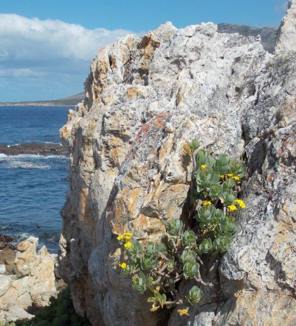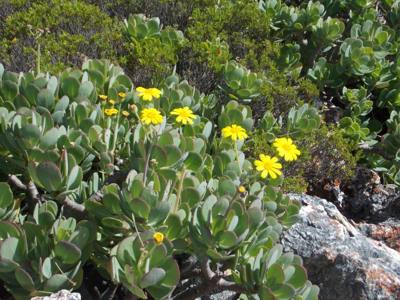Othonna dentata
Othonna dentata L.
Family: Asteraceae
Common names: toothed othonna
Introduction
This blue-grey succulent shrublet is ideally suited to coastal gardens and deserves to be more popular with gardeners.

Description
Description
This succulent shrublet with a fleshy caudex (short, thickened perennial stem) grows up to 700 mm. It is often much shorter when growing close to the high-water mark. The blue-grey hairless leaves are obovate to oblanceolate and borne towards the tips of the branches. Leaves are 37.0-50.0×18.5-25.0 mm and without distinct leaf stalks. The red leaf margins vary from finely to coarsely toothed.

The single yellow flowerheads of about 20 mm across appear at the end of the naked stem. Flowers are also characterised by a single row of more or less united involucral bracts (bracts surrounding the base of a flowerhead). Flowering time is from winter until midsummer (June to December).
Conservation Status
Status
Othonna dentata has a Red List status of Least Concern (LC).
Distribution and habitat
Distribution description
This species is common on inland mountains as well as rocky outcrops and sandy stretches of coastal areas from the Cape Peninsula to Still Bay in the Western Cape. With its habitat so close to the sea, it is rarely exposed to severe temperature differences. Along the coastal strips, plants are often exposed to rather windy conditions and salt-laden sea breezes. Frost is seldom experienced in its distribution area. Plants are often much shorter when growing close to the high-water mark.

Derivation of name and historical aspects
History
The genus name Othonna is derived from the ancient Greek word othonne, meaning 'linen' or 'cloth', and could refer to the soft texture of some of the leaves. The specific epithet dentata refers to the toothed leaves of the species. The genus Othonna, also known as bobbejaankool in Afrikaans, consists of about 140 species that are found from the Western Cape northeast to KwaZulu-Natal and north to Namibia.
Ecology
Ecology
Within its natural environment, Othonna dentata is usually found growing with Coleonema album, Aloe succotrina, Sideroxylon inerme, Berkheya barbata, Cotyledon orbicularis, Crassula rupestris var. rupestris, Delosperma littorale, Pelargonium cucculatum, Ruschia macowanii and Curio crassulifolius.

Uses
Use
None recorded. However, this species is a very interesting garden or pot subject.
Growing Othonna dentata
Grow
This species is easily grown from cuttings. Take cuttings any time of the year and apply rooting hormone to stimulate rooting. Use a well-drained medium like coarse river sand. Place in a cool, well-ventilated area or cold frame away from direct sunlight. Pot rooted cuttings into a well-drained potting soil. Germination success from seed is unknown but since it is a winter-rainfall species, it is probably best sown during autumn.
It should be a useful addition to rockeries, coastal gardens, and sloped sections in a garden, or make for an exciting pot plant with its striking blue-grey foliage. Provided that there is ample drainage, it could also be used in level areas. In frost-prone areas, it is best displayed in a pot on a sunny patio or glasshouse.
This floriferous shrublet is relatively pest-free.
References
- Bean, A. & Johns, A. 2005. Stellenbosch to Hermanus. South African Wild Flower Guide 5, edn 2. Botanical Society of South Africa, Cape Town.
- Goldblatt, P. & Manning, J. 2000. Cape Plants. A conspectus of the Cape flora of South Africa. Strelitzia 9. National Botanical Institute, Pretoria & Missouri Botanical Garden, Missouri.
- Mustart, P., Cowling, R. & Albertyn, J. 1997. Southern Overberg. South African Wild Flower Guide 8, edn 1. Botanical Society of South Africa, Cape Town.
- Raimondo, D., Von Staden, L., Foden, W., Victor, J.E., Helme, N.A., Turner, R.C., Kamundi, D.A. & Manyama, P.A. (eds). Red List of South African plants 2009. Strelitzia 25. South African National Biodiversity Institute, Pretoria.
- Smith, G.F & Crouch, N.R. 2009. Guide to succulents of Southern Africa . Struik Nature, Cape Town.
- Stearn, W. 2002. Stearn's dictionary of plant names for gardeners . Timber Press, Portland.
Credits
Roger Oliver
Kirstenbosch National Botanical Garden
October 2013
Plant Attributes:
Plant Type: Shrub
SA Distribution: Western Cape
Soil type: Sandy, Loam
Flowering season: Spring, Early Summer, Winter
PH: Acid, Neutral
Flower colour: Yellow
Aspect: Full Sun
Gardening skill: Easy
Special Features:
Horticultural zones







Rate this article
Article well written and informative
Rate this plant
Is this an interesting plant?
Login to add your Comment
Back to topNot registered yet? Click here to register.